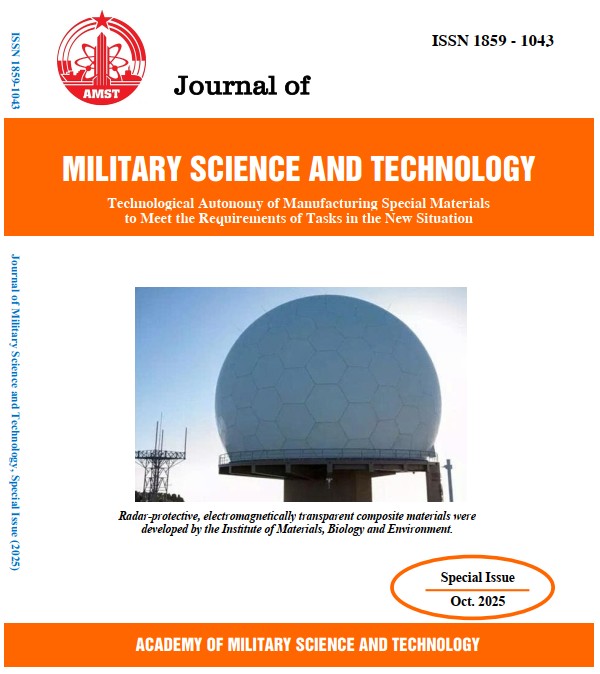Study on the reuse of nanoscale zero-valent iron (nZVI) in a Sono–Photo–Fenton-like process for the treatment of TNT-contaminated wastewater
78 viewsDOI:
https://doi.org/10.54939/1859-1043.j.mst.IMBE.2025.129-135Keywords:
Sono-Photo-Fenton-like process; nZVI; TNT; Iron recovery; Catalyst reuse.Abstract
This study evaluates the effectiveness of recovering and reusing nano zero-valent iron (nZVI) in the treatment of TNT-containing wastewater using the Sono-Photo-Fenton-like (SPF-like) process. Experiments were conducted under fixed optimal conditions: pH = 2.5; H₂O₂ = 40 mM; and initial TNT concentration = 50 mg/L. Results showed that recovered nZVI material maintained good catalytic activity, with TNT removal efficiency reaching over 24% after 4 consecutive reuse cycles. When dry-recovered iron material was combined with fresh nZVI at a 1:1 ratio (1.0 mM nZVI and 1.0 mM Fe(OH)₃), treatment efficiency reached 94.85%, while still reducing the amount of new material used by 50%. These results demonstrate the practical applicability of recovering and reusing iron in advanced oxidation systems, helping to maintain high treatment efficiency, while reducing operational costs and waste generation in the treatment of industrial wastewater containing persistent pollutants like TNT.
References
[1]. Spanggord, R. J. and Suta, B. E. “Effluent analysis of wastewater generated in the manufacture of 2,4,6-trinitrotoluene. 2. Determination of a representative discharge of ether-extractable components.” Environmental Science & Technology, 16(4), 233–236 (1982). DOI: https://doi.org/10.1021/es00098a013
[2]. Liou, M.-J., Lu, M.-C., and Chen, J.-N. “Oxidation of TNT by photo-Fenton process.” Chemosphere, 57(9), 1107–1114 (2004). DOI: https://doi.org/10.1016/j.chemosphere.2004.07.053
[3]. Van Nguyen, H., et al. “Effective treatment of 2,4,6-trinitrotoluene from aqueous media using a sono–photo-Fenton-like process with a zero-valent iron nanoparticle (nZVI) catalyst.” RSC Advances, 14(33), 23720–23729 (2024). DOI: https://doi.org/10.1039/D4RA03907F
[4]. Moradi, M., et al. “A review on pollutants removal by Sono-photo-Fenton processes.” Journal of Environmental Chemical Engineering, 8(5), 104330 (2020). DOI: https://doi.org/10.1016/j.jece.2020.104330
[5]. Walling, S. A., et al. “Fenton and Fenton-like wet oxidation for degradation and destruction of organic radioactive wastes.” npj Materials Degradation, 5(1), 50 (2021). DOI: https://doi.org/10.1038/s41529-021-00192-3
[6]. Cao, G. M., et al. “Regeneration and reuse of iron catalyst for Fenton-like reactions.” Journal of Hazardous Materials, 172(2–3), 1446–1449 (2009). DOI: https://doi.org/10.1016/j.jhazmat.2009.08.010
[7]. Ayanda, O. S et al. “Ultrasonic degradation of aqueous phenolsulfonphthalein (PSP) in the presence of nano-Fe/H₂O₂.” Ultrasonics Sonochemistry, 47, 29–35 (2018). DOI: https://doi.org/10.1016/j.ultsonch.2018.04.012
[8]. Liu, J., et al. “Selective removal of nitroaromatic compounds from wastewater in an integrated zero valent iron (ZVI) reduction and ZVI/H₂O₂ oxidation process.” RSC Advances, 5(71), 57444–57452 (2015). DOI: https://doi.org/10.1039/C5RA08487C
[9]. Shukla, N., et al. “2,4-Dinitrotoluene (DNT) and 2,4,6-Trinitrotoluene (TNT) removal kinetics and degradation mechanism using zero valent iron-silica nanocomposite.” Journal of Environmental Chemical Engineering, 6(4), 5196–5203 (2018). DOI: https://doi.org/10.1016/j.jece.2018.08.018
[10]. Hussain, S et al. “Catalytic activity of metals in heterogeneous Fenton-like oxidation of wastewater contaminants: A review.” Environmental Chemistry Letters, 19(3), 2405–2424 (2021). DOI: https://doi.org/10.1007/s10311-021-01185-z
[11]. Zhang, X., et al. “Degradation of 2,4,6-trinitrotoluene (TNT) from explosive wastewater using nanoscale zero-valent iron.” Chemical Engineering Journal, 158(3), 566–570 (2010). DOI: https://doi.org/10.1016/j.cej.2010.01.054







